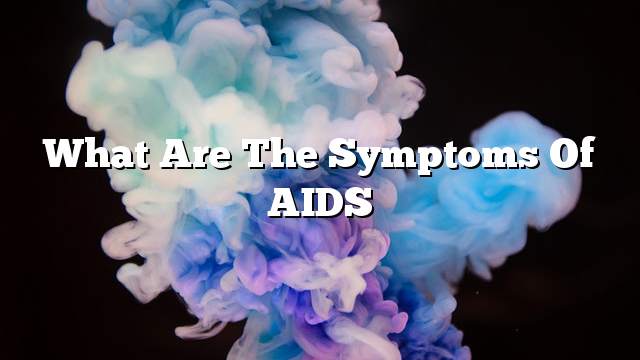AIDS
AIDS is one of the world’s most commonly known diseases and is known to be a threat to human life. HIV is known as the abbreviation for Acquired Immune Deficiency Syndrome, a different virus Of the syndrome or disease, but AIDS is one of the most common diseases that occur because of the virus. HIV infection destroys the human immune system, and it happens gradually over the years, but what ultimately kills the patient is not AIDS, but one of the diseases that affect the body did not find an immune system to resist. People with AIDS often die from various types of cancer. Despite the scientific mutations, research and studies carried out on the disease, there is still no radical treatment to date, but there are signs that a vaccine can be developed to prevent it in the future. According to the National AIDS Foundation in Italy. But all doctors can do now is to give drugs that reduce the severity of the disease, and its role in the elimination of the immune system, and thus work to delay the death as much as possible. In this area, many cases have been recorded that have been able to coexist with AIDS for several years.
Symptoms of AIDS
Some people may develop flu-like symptoms within two to four weeks after HIV infection. These symptoms include:
- High temperatures and chills.
- Night sweats.
- Feeling tired and muscle pain.
- Throat pains.
- Oral ulceration.
- Swelling lymph nodes.
- During this time the virus may not appear in the tests, but the patient is able to transmit the virus to others.
If the person is infected with the virus and is not subject to special treatments, the immune system will weaken and worsen his condition until he becomes infected with AIDS, the late stage of the infection of the virus mentioned, which includes the following symptoms:
- Accelerating weight loss.
- Frequent rise in temperature.
- Night sweats profuse.
- Excessive and unexplained feeling.
- Long-term bloating in the lymph nodes in several places of the body, including under the armpit and neck.
- Diarrhea lasts for more than a week.
- Ulcers in the mouth, anus or genital areas.
- Pneumonia.
- Red, pink, brown or purple spots on or below the skin, or inside the mouth, nose or eyelids.
- Loss of memory, depression, and neurological problems.
AIDS infection
HIV is transmitted by infection with contaminated blood or physical fluids during sexual intercourse, as well as by transmission from the infected mother to her baby through breastfeeding. The international community seeks to reduce the spread of HIV by forcing couples to marry to undergo tests to ensure that neither of them is infected, as well as to promote awareness of safe sex, non-use of syringes and the need to sterilize medical devices.
Causes of AIDS
The symptoms of AIDS are caused by many severe diseases that can not be resisted by the immune system. These diseases are confined to bacterial infection and many viruses and parasites that spread in the air and are resisted by the normal immune system on a daily basis and control the expulsion from the body. Patients suffer from many similar symptoms, such as swollen lymph nodes, fever and persistent sweating, especially at night, general weakness, and weight loss. Other infections are based on parasitic infection on the geographical area where the casualty is present. Infections in Africa are exposed to fungi and bacteria that differ from those in northern Europe.
AIDS prevention
AIDS prevention depends on avoiding dangerous habits and behavior that lead to exposure to HIV, which passes through the blood, body fluids and needles that have been exposed to infected blood.
To prevent this, attention must be paid to the following:
- Know the person to put him and put his partner before sex.
- Use of latex condoms properly before any exercise.
- Determine how many people have sex with them.
- Avoid using injectables outside the hospital clean and sterile.
- The doctor should be consulted if the virus is suspected; medicines may sometimes be prevented if used early.
Treatment of AIDS
Although AIDS has cured him, the infected people are now living for decades after the diagnosis of the disease because of the many drugs that are effective in inhibition of the virus that causes it. The most effective antiviral drugs are antiretroviral drugs, which are used with other drugs to prevent resistance to any drug.
Other uses of AIDS drugs
AIDS drugs are also used as post-exposure prevention, as well as to prevent the transmission of this disease from mother to child as follows:
- Prevention after exposure to the virus : These drugs are used to reduce the likelihood of HIV transmission shortly after exposure. For example, they can be used after a person has had sex with a person without using condoms. These drugs can also be used after a nurse has been exposed to a needle from a needle contaminated with blood carrying the virus. For prevention to be effective, it must be done within three days of exposure to the virus. Post-exposure prevention is administered by giving the person a special drug for 28 days.
- Prevention of mother-to-child transmission of HIV : Pregnant women infected with the virus use their drugs during pregnancy and childbirth to reduce the possibility of transmission to their children. Neonates also receive the drug for 6 weeks after delivery. These drugs reduce the risk of infection with a virus that may have reached the baby at birth.
